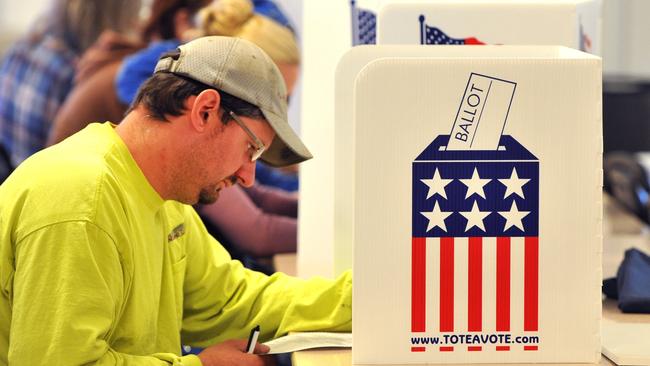
There was good news this week for Donald Trump, with a poll by Politico finding that the “America First” message of his inaugural address resonated with 65 per cent of Americans. Yet the new President’s bellicose economic nationalism is as dangerous for the US as it is for the world.
Underlying that nationalism, with its withdrawal from the Trans-Pacific Partnership and attack on free trade, is a call for Americans to look back in anger. The American people, Trump proclaims, are victims: victims of a “small group” that seized control of their government and ransacked the nation; and victims of “other countries”, which the US has “made rich”, as the wealth of America’s middle class “has been ripped from their homes and redistributed all across the world”.
With the US unprotected from “the ravages of other countries making our products, stealing our companies and destroying our jobs”, a “carnage” has left “rusted-out factories scattered like tombstones” across the nation.
If that vision has force, it is because it has an element of reality. What were once industrial powerhouses are wastelands; after decades of job losses and stagnant or declining incomes, the communities those powerhouses supported in the vast region that stretches from Pennsylvania to Iowa are scarred by hardship and decay. Like the Philipsburg of the poet Richard Hugo’s magnificent elegy, with its “two dead kilns, the huge mill in collapse”, these are places where “the principal supporting business now is rage”.
But no pain has ever been relieved by descending into the darkness of crackpot confusion and cure-all charlatanry. And just as the anger of so many Americans is all too real, so are the economic forces Trump’s rhetoric of victimhood ignores.
After all, no one coerced American consumers into buying foreign goods; if they chose those goods it was because doing so made them better off. In purchasing goods from Mexico, Canada or China, they were no more victims than they were buying from Maine, California or Hawaii.
To say that is not to deny that international trade can harm the workers that imports displace. There is, on the contrary, solid evidence that as imports from China surged from 1 per cent of American GDP in 2001 to 2.7 per cent in 2014, the workers who lost their jobs suffered large and likely permanent income losses.
At the same time, greater import competition dampened the wages of less skilled workers throughout the American economy, reducing the ratio of the earnings of high school dropouts to those of high school graduates by about 1 per cent and increasing the ratio of the earnings of college graduates to those of high school graduates by a bit more than that.
Those effects are substantial, but they have to be placed in context. They were, in particular, significantly worsened by the financial crisis, which both eliminated alternative job opportunities and slashed geographical mobility, slowing the rate at which pools of unemployment in any one area were reduced by migration to places where the economy was picking up.
It would be absurd to blame those impacts on trade; they were part of the costs of one of the deepest recessions in American history, which made adjustment to the “China shock” more painful and prolonged than adjustment to previous increases in imports had been. And it would be equally absurd to conclude that Americans would have been better off had the increase in imports not occurred.
Rather, the most careful study, which is by Lorenzo Caliendo, Maximiliano Dvorkin and Fernando Parro, estimates that even taking account of adjustment costs, the increase in imports from China made Americans better off by 0.2 per cent in the short run and 6.7 per cent in the longer term. And while it finds much greater employment impacts in some areas than in others, the consumer gains and the expansion in export opportunities mean that nearly all parts of the US experience net benefits.
Those results are consistent with experience. For all the criticisms of the North American Free Trade Agreement, virtually every analysis concludes it had little adverse impact on labour earnings, while raising productivity across the American economy as a whole. Indeed, a recent assessment by the Council of Economic Advisers estimates that exposure to international trade, in which NAFTA played a significant part, accounted for a quarter of America’s productivity growth over the past two decades, boosting American incomes.
Not all of that additional income flowed through to workers. But the benefits of greater product variety and lower prices certainly did, with the council finding that because poorer consumers spend so much of their wages on goods made in countries such as China and Mexico, families in the lowest income decile gain 20 times more from imports than do those in the top 10 per cent.
Unfortunately, none of that will blunt Trump’s drive to protect American manufacturing.
From a macro-economic point of view, that drive will be worse than self-defeating.
As the Nobel laureate Robert Mundell showed 50 years ago with flexible exchange rates, imposing a tariff, instead of raising domestic demand, provokes an exchange rate adjustment that shrinks output and employment. And the efficiency costs of protectionist measures must be added to the losses that macro-economic response imposes.
Those costs are hardly likely to be trivial. Roughly half of America’s imports are inputs into the production of other goods, ranging from steel and cement to machine tools and robots. Taxing those inputs makes the goods and services they are used to produce more expensive, hurting America’s competitiveness, and skews decisions by producers (as they decide what inputs to buy) and by consumers. And even if protection helps the domestic manufacturers who compete with imported inputs prosper, their gains will come at the expense of US export-oriented agriculture, which sells more than half the wheat, rice, soybeans and cotton it produces overseas, and of the service industries whose exports have been rising by 6 per cent a year.
Moreover, those distortions are sure to be compounded by the instruments the Trump administration has foreshadowed as the preferred means of achieving its protectionist objectives.
Economists are often fond of the “optimal tariff” theorem, which says that a large economy can benefit by imposing a tariff if exercising power as a buyer or seller allows it to pay less for imports or earn more from exports, thus improving its terms of trade. Whether that ever occurs in practice is doubtful; what is certain is that it won’t with the new administration’s chosen instruments, which are anti-dumping duties and the deals euphemistically known as voluntary restraint agreements, in which the source country restricts the volume of its exports.
Experience in the Reagan years, when Japan agreed to limit its exports to the US of steel, cars and consumer electronics, was telling in that respect: the cartels that were formed to enforce those limits raised the prices at which the goods they controlled were sold to American consumers by 15 to 30 per cent, worsening the American terms of trade while shifting profits to Japan. The measures’ selectivity, as the most competitive exporting countries were targeted while less efficient rivals — who expanded when the restrictions came into effect — were not, then aggravated the costs. So did the restrictions’ lack of transparency, which blunted the pressures for their removal and prolonged their duration.
It is nonetheless easy to see why measures of that kind would appeal to the administration. They suit the new President’s style and are little different from the approach he is adopting domestically, seeking to bully America’s major companies into making choices that bear no relation to their shareholders’ interests in exchange for regulatory relief. How that could be consistent with the free market values he claims to uphold is mysterious; be that as it may, turning trade policy into a protection racket, in every sense of the term, merely invites other countries to do the same.
The risks that poses for Australia, which is heavily dependent on a rules-based international order, are all the greater because the global trading system is already in such poor shape. With the Trans-Pacific Partnership no longer viable, at least as it now stands, and the Trump administration indicating that it prefers bilateral deals over which it can exercise greater leverage, broad-ranging agreements that substantively liberalise trade seem to be off the table. And without strong support from the US, it will be simply impossible to revive the stalled Doha Round of multilateral negotiations, much less reform the World Trade Organisation in ways that would make it possible for multilateral agreements to be reached.
Meanwhile, protectionism continues to spread, with the number of discriminatory measures introduced by the G20 countries increasing nearly fourfold since 2012. That has contributed to the sharp slowdown in world trade, whose growth rate has fallen from being about twice that of global GDP to barely keeping pace. Since 2012, growth in imports of goods and services, measured relative to GDP, has been slower than it was in the five years leading up to the financial crisis in 116 of the 171 countries for which the International Monetary Fund collects data; with Trump legitimating an inward turn, there is every reason to fear that the world trade system may be on the verge of a historic retreat.
That, it could rightly be said, is in no one’s interest. But as two centuries of experience prove, it is scarcely sensible to assume politicians will never be so foolish as to allow international trade to unravel; and it would be even less sensible to think that once trade wars got under way, they could promptly and rationally be brought under control. Least of all should anyone assume that however bad the economic outcomes might be, the political consequences would be readily containable.
Richard Cobden, the great 19th-century advocate of trade liberalisation, argued that the freer trade was, the deeper and broader the ties between countries would be, making for comity and peace.
So far, history has borne him out, as each major breakdown in the world trading order has inflamed tensions and accelerated the descent into war. Despite Trump’s dystopian rhetoric, we are still far from that point. But as they say in Game of Thrones, winter is coming — and this time, it will have no winners.



